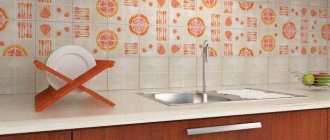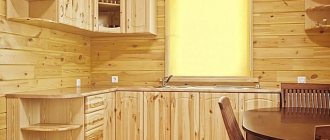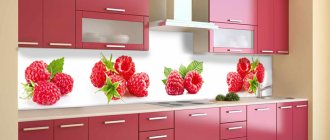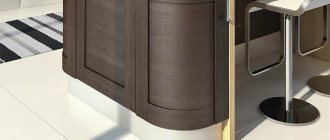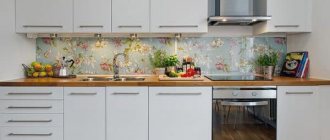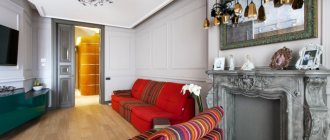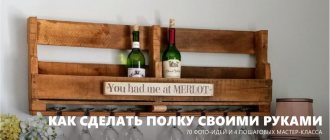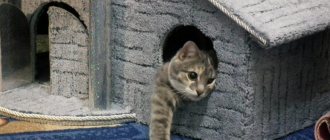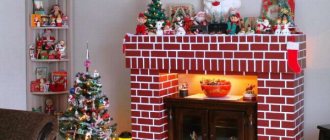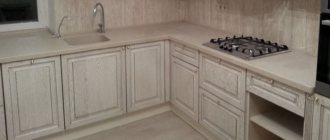It is difficult to find a material that is more durable and wear-resistant than tiles, but the complexity of installation and its rather high cost make us look for other options.
False panels for the kitchen are a modern, functional alternative to ceramic tiles, which were previously widely used to decorate the apron of the work area. The variety of materials, their decorative capabilities and ease of installation are often decisive when choosing the optimal solutions.
Replacing such an apron if necessary or if you want to change the interior is cheaper and happens faster than in the case of ceramic wall decoration.
Why are false panels needed?
False panels are used to hide the unsightly legs of bedside tables or kitchen appliances, using the same material as the set itself. The use of false panels in the kitchen allows you to hide pipes, voids, unsightly cracks, or as decoration. This design will also help in leveling the walls. The false panels match the color of the furniture that is installed in the room to give it an elegant look.
If you don’t know how to hide unevenness or too large gaps, use special false panels, which can be either opening or non-removable. Such false panels are often attached with magnets. You can resort to latches.
A beautiful glass apron can become a bright accent and at the same time hide imperfections
Attention! Builders recommend installing a removable version in cases where they cover wires or pipes, only in those places to which there must be constant access.
How to attach to walls?
The installation of false panels in the kitchen work area is usually performed permanently. But it is possible to install the finishing material so that the masked panel can be removed from the problem area and put back in place.
The process of installing finishing panels can be carried out in several ways. Finishing panels can be mounted on:
- wood sheathing. Bars with a rectangular cross-section are placed vertically in increments of 0.5 m and secured with screws.
- metal profile. This type of lathing is beneficial for kitchens with high humidity and uneven walls.
- staples. In this case, simple construction staples are used to install the panels.
- glue. In this case, installation will require carefully leveling the walls, applying a primer and drying.
See the adhesive mounting option in the following video:
Types of material
Let's look at what materials are used to make false panels.
Tree
For such purposes, cedar, alder, maple or oak are used. Of course, natural wood looks rich. It is environmentally friendly and beautiful. However, using it for the kitchen is not entirely advisable, because it will quickly become unusable due to increased temperature and humidity and may crack or swell. To prevent this from happening, additional processing will be required, and this is an extra expense. Another disadvantage is the very high price
Chipboard
This option is used only in extreme cases. Few people will say a good word about such a foundation. This is, of course, due to low strength and severe deterioration from moisture and temperature. Such a false panel can easily ruin the entire appearance with twisted corners. However, the price is low - there is a large selection of designs.
MDF
This foundation is the best option both in terms of price and quality. It has a varied selection of colors and is resistant to temperature changes and high humidity. Withstands heavy loads. Produced by pressing.
PVC
Common materials for false panels, as they have a number of positive properties. Significant resistance to the negative environment in the kitchen, as well as ease of care. There is a wide variety of colors and it is possible to apply various prints and designs, as well as decorate with mosaics. Light enough.
But they also have disadvantages. Do not install above or near the stove. When heated, plastic releases harmful substances. On such falpanels, a corner may break off or a scratch may appear in the event of mechanical impact.
Glass
This is the most durable material of all presented. To make such false panels, triplex is used, this is one of the types of tempered glass. You can decorate them using photo printing or apply skinali. In general, this material has no serious drawbacks, which is why its price is much higher than others.
Metal
Stainless steel is used to make metal false panels. Easy to care for and reliable at home. Most often used directly near the stove. The material is not affected by corrosion and rust, so it will last a long time. As a rule, it has the same color - matte.
Fake diamond
The material imitates various types of stone: granite, marble. It looks like a complete coating without seams. It looks beautiful in the interior, is easy to use and durable in everyday life. It's not very expensive. In case of mechanical damage (chip or scratch), the restorer can easily restore it.
The tabletop and panel in the same color made of marble in the interior looks expensive and stylish
For your information! To install the panels, it is best to seek the help of a professional who can easily create cozy masterpieces.
Rules for choosing a design
Depending on their purpose or your wishes, false panels can play the role of an accent in the interior or, conversely, not attract attention, copying neighboring surfaces.
- Panels with photo printing, plain but bright colors, or panels imitating exotic wood species, such as zebrawood, are used as accent decor.
- To make the false panel neutral, it needs to be matched to the tone of neighboring surfaces, for example, countertops, kitchen facades or walls. Otherwise, you can choose universal shades and textures - “wood”, white, silver metallic, as well as frosted or transparent glass.
Also take note of the following tips:
- On dark surfaces, dust and stains are more noticeable than on light or variegated ones.
- It is advisable to use colorful and bright wall panels, for example, with photo printing, provided the interior is laconic.
- If your kitchen is small, then you should choose light-colored panels to decorate the work area. They will not reduce the space and will reflect light.
DIY installation methods
Before you begin, you should understand the principles of fixation. It is done with staples, screws or liquid nails. Taking into account the physical properties of the prepared walls, installation is carried out:
- On wooden guides;
- On a metal profile;
- Directly to a flat surface.
Each of the listed methods implies its own technology, represented by a combination of techniques and materials.
If you have curved walls and the material of the false panels is made of polymers, it is better to use rigid fixation with hardware or glue along the guides. This is especially necessary when using decorated glass slabs. For smooth walls, it is advisable to optimize the process by using the technology of gluing false panels directly to the surface.
We will look at how to fix it in a particular case and what tools will be needed using the example of a standard kitchen with panel walls. And although these points significantly depend on the quality of workmanship and the material of the walls, the general difference, say, between fastening using two types of guides, differs only in the type of hardware and the adhesion force of the glue.
Tools
For concrete and brick walls where you plan to install false panels, you must have a hammer drill, a screwdriver or a universal screwdriver, a sealant (glue) gun, a tape measure and a level. In the latter case, an accurate rack level is sufficient. For the profile you will need metal scissors.
For smooth walls, including dry sheet materials, there is no need to drill anything; here it is important to correctly mark and apply glue in an even layer. Therefore, based on this and the type of material of the future apron, you most likely will not need a hammer drill. It is more important to acquire a wide spatula, a flat brush and a hacksaw for processing PVC and wood products and to avoid obstacles.
Preparatory stage
Installation on smooth walls by gluing with liquid nails, usually accompanied by cleaning the surface of wallpaper, crumbling lime, and plaster. If false panels, in addition to metal and glass panels, were purchased with a reserve in length, then it should be cut in advance, taking into account the bypass of natural obstacles of sockets, furniture protrusions, and walls before applying the adhesive.
Kitchen walls that are curved along the plane can only hold the panels along guides, that is, along the sheathing. Regardless of the type, it is necessary to cut them to length. If the kitchen has high humidity and poor ventilation, soak unpainted wooden guides with any antiseptic (bio-impregnation) before using them.
What are the benefits of MDF decor panels, disadvantages and advantages
The MDF wall top is a thin, flexible sheet covered with decorative plastic or PVC film. Most often this is an imitation of the texture of stone, textiles or a fantasy design.
Manufacturers of postforming produce MDF decor panels for kitchen aprons with a standard width of 600 mm and a length of 3050 mm. The material can be easily cut to the desired length. The ends of such false panels remain untreated. It is difficult to glue them with an edge due to their thin thickness (usually 4-8 mm). Therefore, if the kitchen design project involves an open edge of the wall panel, you need to provide some design option. The easiest and cheapest way is to use plastic genesis for laying tiles. It can be matched to the color of the kitchen false panel and pasted during wall mounting.
Space under the sink
The communications of the sink, its pipes, siphons and the sink itself do not allow full use of the space under the sink. But there is a way out. You can use a special cabinet in the shape of the letter “P”. This is the optimal place to store cleaning products, sponges, wipes and other sink supplies.
The cabinet in the shape of the letter “P” goes around the communications and does not interfere with the functioning of the sink
Having even the smallest kitchen, it can be stuffed so that in terms of functionality it will not be inferior to any large and spacious kitchens. You just need to be smart and creative.
What it is?
A decorative finishing board is commonly called a false panel.
It can not only effectively decorate the interior, but also hide the shortcomings of the room. It is often chosen as an apron. It can be based on decorative sheets made from laminated chipboard, less often from MDF, in which one side has a beautiful design.
Experts recommend installing false panels when the need arises:
- replace the old kitchen apron with a new one;
- disguise the corrugation from the hood;
- close communications, niches, defects, irregularities;
- cover furniture legs;
- close the gaps formed between the wall and the cabinets;
- create conditions for decorative lighting;
- give the walls a flat surface.
The photo below shows an example of corrugation camouflage:
And in the other photo below is the wood-look finish of the MDF apron.
Finishing with decorative slabs to imitate concrete walls:
Main purpose
Finishing false panel slabs are needed mainly for decorative purposes, since other means and structures are used to strengthen or insulate the internal walls of the house. The main purpose of false panels is to mask existing imperfections in a wall or other area, such as cracks and voids. It is worth acquiring them in the following cases:
- if there is a need to level a small section of a horizontal surface;
- to improve the appearance of nondescript areas between interior parts;
- to hide electrical wiring and water pipes;
- to hide any fastening structures or supports;
- if you need to cover niches;
- if it is necessary to protect walls from moisture, for example, in the kitchen near the stove or in the bathroom.
In some situations, this type of finishing material may be useful in the process of decorating lighting. In this case, products are selected in accordance with the requirements for the color background of walls and furniture.
Selecting the type of fastening
We recommend starting with choosing a mount. The sequence of actions when assembling an IKEA cabinet and installing it depends on this. There are two types of fastenings:
- corners or hangers,
- mounting rail.
Installing furniture on corners and hangers requires the most accurate height measurement. The cabinet is attached using screws or dowel-nails, the location of which on the wall is not adjustable. Corners are convenient to use on uneven surfaces. Some cabinets are installed on corners by default.
An example of such furniture is the KNOXHULT wall cabinet.
The mounting rail is a metal strip that is attached to the wall with screws. The kitchen cabinet is mounted on a rail using hooks fixed on its back wall. The rail allows you to adjust the position of the cabinet horizontally and vertically (within 2 cm) without dismantling.
Such fasteners greatly simplify installation - the cabinet can be hung on a rail even alone. If the wall is slightly uneven, so that all the fronts of the wall cabinets remain in the same plane, it is enough to adjust the position of the rail. While when using corners, the wall will have to be leveled, since they are screwed close to the surface.
METHOD hanging frames can be secured using either corners or a mounting rail.
Pseudo boxes and false facades: the art of camouflage
When there are a lot of things and not enough space, imagination and ingenuity are required to compactly place everything you need and hide household appliances where their appearance is completely inappropriate.
One of the techniques that is used in such cases is imitation of drawers and false facades. They not only disguise “extra” objects, but also help maintain the integrity of the interior, merging with the decor. These designs are especially in demand in the kitchen and bathroom, but are also useful in other rooms.
Dura Supreme Cabinetry
The most common option is household appliances hidden in a cabinet or cabinet. For example, a washing machine in the kitchen will not improve the overall impression of the interior, but what if there is simply no other place in the house for this vital appliance? There is only one way out - hide it out of sight; you can do the same with a refrigerator, dishwasher, etc.
The design of the built-in dishwasher exactly repeats the design of the kitchen facades with hinged doors and a drawer. When closed, it is impossible to recognize a “fake”. Braams
Vanity unit with uniformly designed fronts. The secret is that a washing machine is hidden behind one of the doors. Design: Goldfish Interior
Imitation drawers can hide not only household appliances, but also various devices, for example, spacious rotating storage structures, etc. Design by Braams
False drawers are very practical when it comes to rational use of space under the sink in the bathroom or kitchen. The configuration of the upper tier of the cabinet is, as they say, non-standard. By shortening the doors and placing a narrow folding panel above them, imitating the front of a drawer, you can get full-fledged shelves at the bottom and an auxiliary compartment for storing small items at the top. The appearance of the furniture will not be affected; on the contrary, the additional element will support the rhythm and geometry of the front part of the set.
Option for arranging space under the sink from Studio Grayhouse
The hinged door looks like a drawer from the outside. Behind it are plastic containers for storing sponges, rags and small household chemicals. Design by Bloomsbury Kitchens
What else can a false façade hide? Anything from extra sockets to a fold-out ironing board, trash can or laundry basket in the bathroom. The advantages of such a solution are undeniable when it comes to interiors in a classic style: all modern functionality remains at hand, but, being neatly hidden, does not disturb the overall harmony.
Additional sockets and space for a hair dryer under the sink, Sawdust 2 Stitches project
Fold-out ironing board behind drawer-style door, Closet America
Laundry basket. Change Design Group
If the kitchen does not have enough work surfaces, the top drawer can be replaced with a pull-out table for cutting food.
Pull-out cutting board with scrap container, Serena Thompson
Similar designs can be used in the office and in the living room, where a table for papers or a laptop is always useful.
Design by Valet Custom Cabinets & Closets
Design by Valet Custom Cabinets & Closets
False doors do not always open. Sometimes stationary panels, made in the same design as the rest of the set, serve as a towel rack or simple decor.
Raised panels for the kitchen: an inexpensive alternative to ceramics
Traditionally made of ceramic tiles, the finishing of an apron in the kitchen today is losing its relevance due to the labor intensity and high cost of both the material and the work involved in its installation.
The usual, strong and durable tiles have been replaced by a variety of and no less functional false panels. A wide selection, rich palette and the possibility of self-installation make them increasingly popular and in demand.
